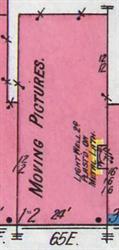
|
|
Isis Theater (Isis Theatre, Broadway Theatre, Colony Theatre, Broadway Theatre, Tower Midtown Theatre, Towne Theatre, Palace Theatre, Broadway Theatre) 65 East 300 South Salt Lake City, Utah (Before 1908 - 1976) |
In November 1908, G. H. Wilson, a “pioneer in the moving picture business” in Utah, was secretary and treasurer of the Isis Theatre Company in Salt Lake City. Wilson and his associates were also in the process of building the Alhambra Theatre in Ogden, which was to be “along the same lines as the Isis”.[1]
Max Florence was manager of the Isis Theatre in 1910.[2] Florence was a saloon operator who, by 1908, “practically controlled everything in the film and picture show line in the city”. His business later suffered and he had to turn over to creditors all his assets except the Shubert and Elite Theatres.[3][4] In 1911 Florence tried to blackmail the Church of Jesus Christ of Latter-Day Saints when he attempted to sell photos which he had secretly taken of the interior of the Salt Lake Temple.[4]
]
About 1919, Harry R. Rand took over management of the Isis Theater. Rand established a chain of theaters in Salt Lake City, including the Empire, Photoplay, Daniels, and Rand theaters. Although he gave up most of his other holdings, Rand continued to manage the Isis Theatre until he retired in 1933. He died of a heart attack two years later.[5]
Dan Kostopulos, a veteran Salt Lake showman and benefactor to the city's under-privileged children, purchased the Isis, probably in 1933.[6]
A 1935 advertisement for the Isis Theatre described it as “attractively and beautifully furnished, tastefully decorated and very comfortable in every way, pleasing to the eyes, restful to the tired nerves and jaded senses and here amid attractive surroundings you are entranced by the excellent and dreamy music and the world's greatest actors. You see romance, fiction and travel and all the various phases of human life are here depicted not only for the entertainment of the public, but as well for the education and intellectual uplift of the race.”[7]
By 1937 the Isis was renamed the Broadway Theater. Another flowery-worded advertisement for the theater proclaimed, “The management of the Broadway theater always makes it a point to secure the best pictures available. New screen hits are brought to town as soon as it is possible. The most popular stars of Hollywood are features in their pictures. The Broadway Theater is comfortable and clean, the air is fresh and always at the most comfortable temperature. . . . the Broadway theater is one that deserves the respect and patronage of every theater lover in this vicinity.”[8]
Kostopulos sold the Broadway Theatre in 1952.[6] In 1953 the theater was "completely refinished in an old French colonial style" and re-opened on 6 May 1953 as the Colony Theater.[9]
In 1959, Kostopulos re-purchased the movie house with plans to completely refurbish and redecorate it with new seats, carpeting, projectors, and a Cinemascope screen. The theater was scheduled to reopen on 1 February 1959, once again as the Broadway Theatre.[2]
In 1961 the theater was known as the Tower Midtown Theatre and was connected with the Tower Theatre at 900 South and 900 East.[10]
From 1962 to 1974, the theater was known as the Towne Theatre.[10]
About 1974, Mini-Movies Entertainment Inc. started showing X-rated movies at the theater, which was then known as the Palace Theatre. In April 1976, Lee Harper, vice president of Mini-Movies, announced the theater would close, following an incident of what he called police brutality.[11]
According to Mr. Harper, City Judge Paul G. Grant, pornography prosecutor Ted Cannon, and several members of the vice squad attempted to purchase tickets to an X-rated film. When Harper's wife, who was four months pregnant, refused to sell the tickets, Judge Grant ordered her to be arrested and the business license removed. An officer then grabbed Mrs. Harper by the hair, threw her headlong into a wall, and slugged her in the stomach.[11]
In the press conference where he announced the closing, Mr. Harper complained bitterly of the harassment the theater had endured during its year and a half of operation. He claimed the Church of Jesus Christ of Latter-Day Saints transported picketers in church buses to the five theaters showing X-rated movies. He also threatened the life of Judge Grant and accused the LDS Church of being involved with the assassinations of John and Robert Kennedy, and also Martin Luthar King.[11]
From about 1976 to 1984, the theater was known as the Broadway Theatre. Former Deseret News movie critic Chris Hicks remembers the Broadway as "an older, rundown subrun movie house where they showed martial arts movies and a spate of mid-'70s films. ...the old Broadway was a great place to catch up with missed opportunities -- from classics to loony kung fu."[12]
1. "Personal Mention", Park Record, 14 November 1908, page 3
2. "Isis Theatre", Salt Lake Herald, 11 March 1910, page 2
3. Deseret News, 11 November 1910
4. "Iím Here for the Cash": Max Florence and the Great Mormon Temple", By Gary James Bergera, Utah Historical Quarterly, Volume 47, Number 1 (Winter 1979), Utah State History CD-ROM
5. "Pioneer Theater Operator Dies Of Heart Attack", Salt Lake Tribune, 18 November 1935, page 36
6. "S.L. Showman Buys Theater", Salt Lake Tribune, 14 January 1959, page B3
7. "Isis Theatre", Murray Eagle, 4 July 1935, page 6
8. "The Broadway Theatre Offers the Latest in Picture Entertainment", Murray Eagle, 4 March 1937, page 8
9. "Theater Opening Slated Today", Salt Lake Tribune, 6 May 1953, page 32
10. Salt Lake City telephone directories
11. "X-Rated Movie Theater to Close", Salt Lake Tribune, 24 April 1976, page B15
12. "Woe's the word for moviegoers in downtown S.L.", Deseret News, 23 June 2000, page W1
